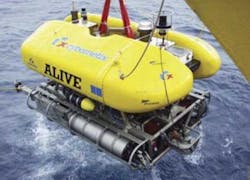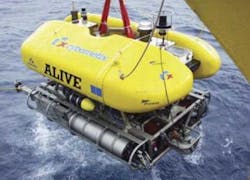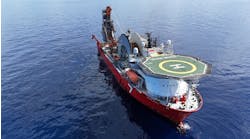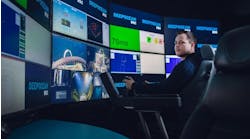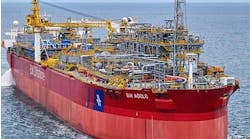In the offshore sector, autonomous underwater vehicles (AUVs) are still considered an emerging technology. However, since 2001 they have been used commercially to perform seabed surveys for the oil and gas industry, and have proven to be more effective in this field, both technically and financially, than traditional towed fish or hull-mounted instruments.
With AUVs, survey sensors can be deployed close to the seabed, giving accurate survey data, while the vehicles’ high level of maneuverability generates significant savings on operation time through reducing the extent of the survey path. C&C Technologies and Fugro are both equipped with Hugin AUVs, which they use to perform such surveys for major oil operators on a regular basis.
AUVs also have the potential to transform the approach to operation and maintenance of subsea fields. Toulon-based ECA, for instance, has undertaken the development of an AUV capable of performing flowline or riser inspection. The ability to perform subsea inspection directly from a platform or an FPSO at any time, without having to mobilize/demobilize a dedicated ROV surface vessel, should lead to significant opex reductions. It should also transform the conventional operational philosophy offshore from being purely reactive (because of high associated costs) to proactive.
The oil and gas industry’s growing acceptance of AUVs has reinforced Marseille-based Cybernétix in its belief that the bulk of the upcoming market lies in the area of intervention AUVs, meaning an AUV capable of physically interacting with its environment. Since 1998, Cybernétix has focused its R&D on putting in place the building blocks to enable AUVs to perform meaningful operations in a deepwater field environment.
With the company’s Swimmer and Alive prototype vehicles, the accent was on making subsea well inspection, maintenance, and repair operations accessible to AUVs. These vehicles are fitted with manipulation capabilities that enable them to perform tasks such as valve closing/opening and connector hot stabbing on standard christmas tree ROV panels. Alive was demonstrated successfully at sea in October 2003 when it accomplished autonomously these pre-programmed operations on an ROV panel mock-up.
Since then, Cybernétix has been looking to enlarge the spectrum of applications for intervention AUVs. For example, in association with Advanced Subsea SAS, a specialist provider of metrology and construction support services, Cybernétix has been working on a construction support AUV. This would be deployed from the main construction vessel, and would complement existing on-board ROVs for operations remote from the construction vessel, such as cutting-to-length, transponder installation and retrieval, pipe crossing beaconing, valve opening, pipe flooding, and so on. If successful, the concept could render obsolete the need for a construction support vessel, in addition to the main construction vessel.
Cybernétix is also part of a European-funded scientific project, called Seabee, the goals of which are to use AUVs to perform seawater and seabed assessment surveys such as Environmental Impact Assessment and integrated Coastal Zone Management. To this end, Cybernétix is re-configuring its open-frame Alive AUV to incorporate a landing skid. The vehicle will also be equipped with video, water sampling, core sampling, and environmental data gathering capacities to allow automated inspection and sampling of marine environments.
The vehicle will be programmed for surveying and landing on specific locations on the seabed. To meet the requirements of the project, the following components will be combined in a measurement module:
• EcoLAB nutrient analyzer
• Chelsea MINIPack CTD-F
• ChelseaMINItracka in-situ fluorimeter
•Challenger oceanic core, water and particulate multi-sampler
• Video camera
A PC will control the components and a frame grabber will enhance them by storing the video streams on a local hard disk. The computer will control the measurement tasks and allow a high-level communication between the operator and these tasks. All sensors and the computer system will be assembled on a mechanical frame and will replace the Alive’s manipulator system. The module will be integrated as a part of the local AUV Ethernet TCP/IP network and supplied with power by the AUV.
Using Seabee, pollution of coastal waters and sediments can be detected and quantified in an automated way. Seabee can take and analyze water and sediment samples to determine bathing water quality, as well as the contamination of specific coastal regions, following oil spills or other chemical hazards. In this way, dangerous substances in the sea can be detected earlier and their harmful effects dealt with more quickly and efficiently.
This capability has drawn serious interest from oilfield operators that have to cope with increasingly stringent environmental protection regulations. In an offshore context, the AUV is permanently posted on a host installation and is capable of detecting oil leaks and periodically monitoring the area and surroundings of a deepwater subsea oil field to search for environmental contamination. It should serve to promote and accelerate the acceptance of such systems.
Three campaigns at sea are scheduled with the Seabee-configured Alive between July and September this year. In parallel, Cybernétix will soon start work on a mocked-up AUV to assess and enhance the capabilities of these systems for permanent duty on subsea facilities.
